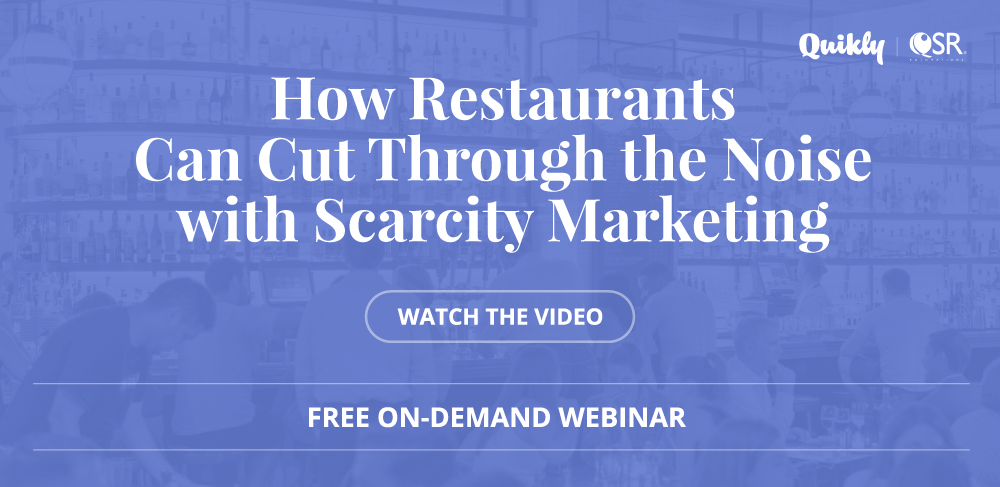
How restaurants can cut through the noise with scarcity marketing (webinar recap)

QSR Automations and Quikly hosted a webinar called “How Restaurants Can Cut Through the Noise with Scarcity Marketing” on Thursday, November 7. If you missed it, don’t worry. We got you covered.
Vice President of Marketing at Quikly, Kristy Sharrow, and Director of Marketing & Communications at QSR Automations, Amber Mullaney, brought decades of marketing experience between the two of them to dish out some knowledge about the restaurant industry.
The webinar began by highlighting scarcity marketing examples: Wendy’s spicy chicken nuggets. Burger King’s Ghost Whopper. Popeye’s chicken sandwich. McDonald’s McRib. Olive Garden’s coveted Lifetime Pasta Pass.
“Now, some of these examples are anomalies, and that’s worth mentioning,” Sharrow said. “But, there are ways that restaurants can use the psychology behind this marketing — even simply — to achieve incremental results. And that’s what we’re here to talk about today.”
[Get the webinar recording: “How Restaurants Can Cut Through the Noise with Scarcity Marketing”]
Using scarcity to cut through the noise
Using consumer psychology in a marketing strategy can grab the attention of a distracted consumer, who has an overwhelming amount of options. The National Restaurant Association indicates there are more than a million restaurant locations, all vying for customer attention, across the United States.
“In our modern landscape, consumers have more purchasing options in virtually every aspect of their lives,” Mullaney said. “Nowhere is this more evident than in the restaurant industry.”
Signaling scarcity can help restaurant marketers attract diners.
The two brought the conversation back to the earliest days of mankind. Our ancestors used scarcity cues around them to forecast what would happen next in order to survive, according to Consumer Psychologist Dante Pirouz. Today, we process scarcity similarly. When we perceive something as rare, heightened cognitive processing kicks in, which often elicits anxiety when forecasting the future absence of said rarity.
As things become less accessible, we lose freedoms, according to the research of Dr. Robert Cialdini, author of “Influence” and consumer psychologist. And people hate to lose freedoms.
In fact, the psychological reactance theory says humans respond to the loss of freedoms by wanting them (as well as the goods and services associated with them) significantly more.
This can be evident as early as age two, Sharrow explained. At this age, children are beginning to understand they’re an individual with their own freedom, which makes them especially sensitive to restrictions — hence the “terrible twos.”
Integrating scarcity into restaurant marketing
Mullaney then dove into how scarcity can be integrated into a restaurant’s marketing strategy.
"A limited-time offer suggests that if a customer doesn't take action within a particular time frame, they'll miss out," she said. "The offer motivates them to act sooner than later."
She explained every restaurant is unique, so the specifics of a limited-time offer will vary site-to-site, but there are some universal variables restaurants can play to. Operators can create limited-time offers around seasons, specific hours and new items.
Knowing what to put on a limited-time offer requires a little bit of strategy, according to Mullaney. She suggests menu engineering, which is the process of breaking down a menu to identify the profit margins of different items.
A restaurant will then need to let consumers know what they can’t stand to miss out on. Before the offer begins, let them know when it ends. Specify what they’ll get from the promotion. And be sure to keep reminding people of the promotion while it’s running.
Sharrow ended by encouraging attendees to think of scarcity as a tool marketers can also use broadly.
“Think of it as a motivator to increase consumer response across any key activities or goals you have,” she said. “You can use it to motivate increased offer or promo redemption, CRM growth and even key customer lifecycle events, like acquisition, first-to-second purchase and surprise and delight.”
Watch the webinar recording for the full session:

Andrea Gonzales-Paul is a brand journalist at Quikly. Her background is in storytelling, specifically working in TV news and documentary filmmaking.

